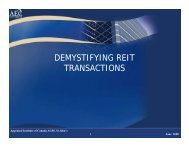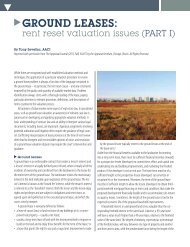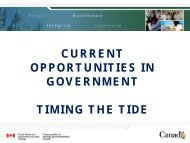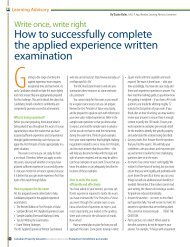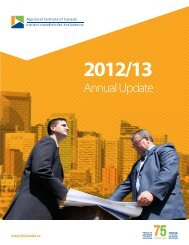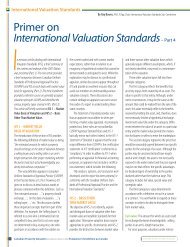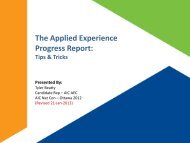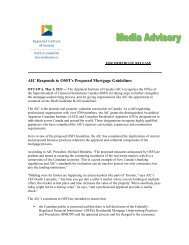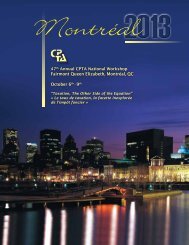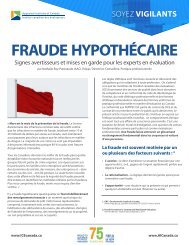Book 1 - Appraisal Institute of Canada
Book 1 - Appraisal Institute of Canada
Book 1 - Appraisal Institute of Canada
You also want an ePaper? Increase the reach of your titles
YUMPU automatically turns print PDFs into web optimized ePapers that Google loves.
Pr<strong>of</strong>essional quality, clear communications,<br />
and delivery on time and on budget are the ingredients for a<br />
successful assignment and a satisfied customer.<br />
Make sure you clearly understand<br />
what your client’s needs are and<br />
only accept the engagement if you<br />
are certain that it is within your<br />
realm <strong>of</strong> expertise. One <strong>of</strong> the best<br />
ways to limit your pr<strong>of</strong>essional<br />
liability risk is to limit your services<br />
to those for which you are well<br />
qualified. The <strong>Institute</strong>’s pr<strong>of</strong>essional<br />
liability insurance covers members<br />
only for the kinds <strong>of</strong> services that<br />
are identified in the Standards and<br />
for which members are trained.<br />
If you do not have the know-how<br />
to undertake a particular type <strong>of</strong><br />
assignment, consider taking specialized<br />
training such as the courses<br />
available through the pr<strong>of</strong>essional<br />
development program <strong>of</strong>fered by the<br />
<strong>Institute</strong> and its provincial associations.<br />
Once you have determined<br />
that you are competent to perform<br />
the work that the client needs to<br />
have done, work with the client to<br />
define the assignment as clearly as<br />
possible. Outline expectations <strong>of</strong><br />
both the client and yourself before<br />
any work begins.<br />
An important way to achieve this<br />
is through a written letter <strong>of</strong> engagement.<br />
Consider giving your clients<br />
a written letter <strong>of</strong> engagement or<br />
other formal means <strong>of</strong> outlining what<br />
services you will, and will not, be<br />
providing. Review and sign this document<br />
with your client to ensure that<br />
you share the same understanding<br />
<strong>of</strong> the work to be performed.<br />
Ensure that engagement letters,<br />
including a detailed description<br />
<strong>of</strong> the scope <strong>of</strong> services you will<br />
provide, the limitations <strong>of</strong> the<br />
services, client responsibilities, and<br />
other agreed-upon engagement<br />
terms, are signed by the client.<br />
Well-prepared engagement letters<br />
are an effective tool in defending<br />
against allegations that you failed to<br />
provide services that were, in fact,<br />
never agreed to. However, remember<br />
that a good engagement letter alone<br />
cannot protect you in the event <strong>of</strong> a<br />
lawsuit, if the service obligations are<br />
not met.<br />
In addition to a letter <strong>of</strong><br />
engagement, all important<br />
communications with clients and<br />
other pr<strong>of</strong>essionals that may work<br />
for the client should be documented.<br />
This is especially important when<br />
more than one pr<strong>of</strong>essional is<br />
involved in providing services to the<br />
same client.<br />
Make sure everyone on your<br />
staff documents every step in<br />
the process for all assignments.<br />
Encourage everyone who is involved<br />
to review documentation on any<br />
similar previous actions, before<br />
they initiate any new ones. Review<br />
your documentation procedures.<br />
See if there are any holes in your<br />
process, and take steps to address<br />
them. The Standards require that<br />
all work records be retained for a<br />
period <strong>of</strong> at least seven years. The<br />
period may exceed seven years<br />
due to such things as legislative<br />
requirements, which may vary<br />
across <strong>Canada</strong> for differing types <strong>of</strong><br />
assignments.<br />
In today’s world, anyone who<br />
performs a pr<strong>of</strong>essional service is a<br />
prime candidate for a lawsuit. The<br />
appraisal pr<strong>of</strong>ession is no exception.<br />
Be pr<strong>of</strong>essional at all times and<br />
ensure that required due diligence is<br />
done on every assignment. Develop<br />
strategies to minimize or limit<br />
exposure to potential claims.<br />
Clarify your responsibility for fraud<br />
detection and take affirmative steps<br />
in each engagement to assess the<br />
potential for fraudulent reporting<br />
<strong>of</strong> information and corresponding<br />
procedures to provide reasonable<br />
assurance <strong>of</strong> detection. Electronic<br />
reports that are digitally signed and<br />
sealed with quality encryption s<strong>of</strong>tware,<br />
such as that <strong>of</strong>fered through<br />
the <strong>Institute</strong>, <strong>of</strong>fer the best protection<br />
against fraud.<br />
Should a claim arise, you will<br />
want to know how to handle it.<br />
Make sure you know how to report<br />
a claim and what information you<br />
should have handy. You will also<br />
want to know when your policy<br />
requires you to report a claim or<br />
circumstances that could lead to a<br />
claim. Document these procedures<br />
and file them where you can find<br />
them easily.<br />
Exercise the practice <strong>of</strong> defensive<br />
appraisal in all engagements.<br />
In all stages <strong>of</strong> an engagement, ask<br />
yourself this question, “Am I able to<br />
defend my work” This should be<br />
the last check on your work before<br />
signing <strong>of</strong>f on a report.<br />
The above measures are by no<br />
means exhaustive and there are<br />
many more ways that a pr<strong>of</strong>essional<br />
can take care <strong>of</strong> business<br />
in a manner that protects both the<br />
practitioner and the public. But, in<br />
the end, it boils down to being sensitive<br />
to clients’ needs, and ensuring<br />
that the work product adheres to the<br />
Standards while meeting the client’s<br />
expectations. Pr<strong>of</strong>essional quality,<br />
clear communications, and delivery<br />
on time and on budget are the ingredients<br />
for a successful assignment<br />
and a satisfied customer.<br />
C a n a d i a n<br />
Appraiser<br />
E C<br />
Volume 51 • book 1 • 2007 valuateur<br />
a n a d i e n 11



